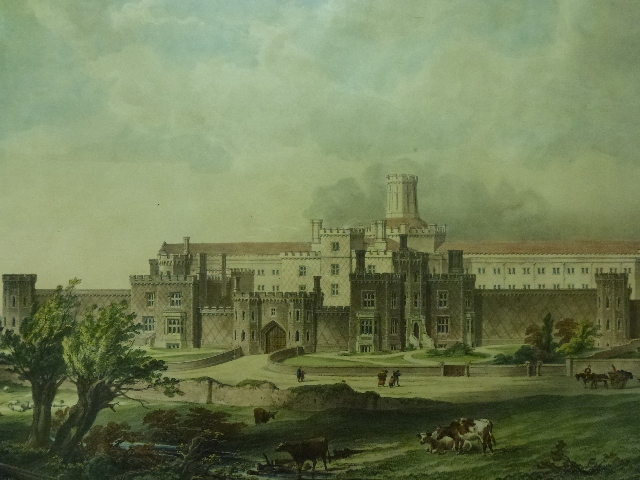Reading Gaol

Lithograph of The New County Gaol (architects: Scott and Moffatt), 1844
Reading Gaol is infamous as the place where Oscar Wilde was imprisoned in cell 3.3 between 1895 and 1897. After he was released Wilde wrote his famous poem The Ballad of Reading Gaol about his experience of the Gaol.
The first County Gaol on the site opened in 1796. The present neo-Tudor building of 1844 was one of the earliest designs by George Gilbert Scott (later Sir Gilbert). He designed it with his partner William Bonythorn Moffatt. Their outer prison wall with its castellated towers and gatehouse was demolished in 1971, but the original cell wings and central tower remain.
Between 1835 and 1845 Scott and Moffatt also designed over 50 workhouses, 15% of the national total. In his later years Scott was recognised as one of the most influential and prolific architects of his generation. Scott’s gothic revival masterpieces include the Midland Grand Hotel at St Pancras Station and the Albert Memorial in Hyde Park, London. He also restored Reading’s Abbey Gateway in 1861.
For many years Reading had two prisons; the County Gaol and the Borough Bridewell. The County Gaol was in Castle Street on the site now occupied by St Mary’s Church. This prison was described by prison reformer John Howard between 1773 and 1779. It housed both convicted felons and debtors. Men and women shared a day room, but had separate night rooms. The men occupied a large dungeon. The gaoler was licensed to sell beer and wine to the prisoners. In 1793 this prison was replaced by a purpose-built gaol in the Forbury.
The Borough Bridewell was based in the nave of the former church of Greyfriars. At the Dissolution of the monasteries, the nave was acquired by Reading Corporation for use as a Guild Hall. By 1578 it had become a hospital for the poor and from the early seventeenth to the mid-nineteenth century it was the local house of correction and bridewell. It was derelict by the 1850s.
In September 2013 the government announced the permanent closure of Reading Prison. It was too expensive to run and will be sold for conversion of the Listed Buildings to new uses.